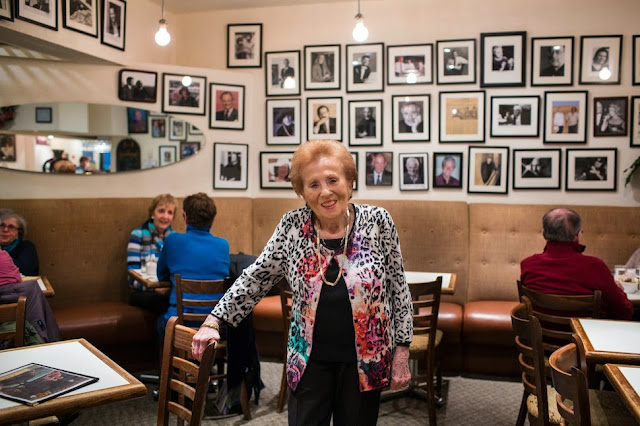Homage to Toronto's Yorkville Landmarks the Coffee Mill and Le Trou Normand
Homage to Toronto's Yorkville Landmarks the Coffee Mill
and
Le Trou Normand
Up until just a few months ago, Le Trou Normand remained the
oldest operating fine dining restaurant in Yorkville. Coincidentally, The Coffee Mill a venerated European-style cafe which recently
celebrated 51 years in business closed earlier this month.
Martha von Heczey’s Coffee Mill opened in May, 1963, in the
now-demolished Lothian Mews, on Bloor Street. In 1973, von Herczey moved two blocks north to a mini-mall with
Yorkville Avenue on one side, Cumberland Street on the other. There was a secluded terrace
with an expandable awning in the event of rain. The Coffee Mill was
practically right across the street from Le Trou Normand and it was one of my Yorkville haunts for over 30 years.
Ms. von Heczey’s late husband Laci, a well-known wrestling champion, liked to wander around Yorkville with a tame cheetah on a leash.
Interestingly, in 1984, von
Herczey even managed to regain the UNICEF fountain — the centrepiece at Lothian
Mews, which had been placed in storage and relocated it to her new location.
Among
those luminaries whose autographed photographs hung on the restaurant walls
like they do at Sardi’s in New York were: Al Waxman, Barbara Amiel, Gordon
Pinsent, Tom Kneebone, Edward Greenspan, Anne Mirvish, Dusty Cohl (who co-founded TIFF), Pierre
Berton and Anna Porter The cafe was frequented by such Canadians luminaries as Norman Jewison, Margaret Atwood and Leonard Cohen, who loved the cafe's secluded patio and plates of Hungarian goulash, liverwurst and schnitzel.
Original Location of the Coffee Mill in the Lothian Mews
Coffee Mill Terrace August 2014
Coffee Mill Terrace August 2014
Both businesses were tucked away from the beaten path, anomalies with retro-charm but relics of a
former era. In their
heyday, Yorkville was a bustling place to be. It has been years since the
restaurants lost their cachet but both businesses have long been celebrated as
a throwback to gentler times when the world was a simpler, kinder place.
In recent years, the 41-year-old Le Trou Normand attracted
prospective diners – and tourists – with a weather battered sign hanging on the right side of the street entrance and
a framed menu box listing the specialties of the house. You had to climb
a few short steps under a decorative wrought iron archway decorated with the
restaurant’s name and coat of arms and follow a cobblestone terrace to the
front door. In recent years, the entrance to my mind was like a portal in time
leading to a style of restaurant that is all but obsolete in Toronto. The restaurant also attracted its fair share of celebrities in its day.
The restaurant which
had been operating since 1973, had always reminded me of the rustic French
country bistros or the small working class restaurants situated on the Left
Bank and Latin Quarter of Paris when I was in my twenties. The name Le Trou
Normand referred to the traditional Norman palate cleansing shot of Calvados
between courses which is supposed to restore the appetite.
Le Trou Normand is the restaurant where I first became
acquainted with a young Susur Lee in 1984, who has gone on to inhabit the top
echelon of world chefs. My path crossed Susur’s again at Lela restaurant, where
he began to pioneer his ground-breaking fusion of traditional French and Asian
cuisine.
On my last visit to Le Trou Normand a few months before it
closed the dining rooms with their stuccoed walls, washed-out upholstery,
antique porcelain in farmhouse hutches, and worn Persian rugs over the tiled
floors had all but faded into to obscurity.
Le Trou Normand Terrace
A Memory of Le Trou Normand
There was always a look of disbelief in the eyes of new
waiters after working their first shift at Le Trou Normand. As quick as Babette
(not the real name of my esteemed former colleague) hired them, Chef would fire
them. Sometimes waiters would go out to sweep the terrace and never return. Babette, who for all intents and purposes ran the front of the house, realized it was
foolhardy to form attachments with the staff.
When she hired someone capable and compatible with Chef, she held on to
them for dear life, knowing they could soon tire of the histrionics. Or worse,
she might spend weeks training someone, and Chef might fire them for some minor
infraction or simply because the weather was bad. It was a revolving door of
staff. And that’s pretty much what happened over a period of many years that I
was acquainted with the restaurant.
On my first day of work at Le Trou Normand, there were two other
waiters besides myself starting that day. Both were affable and experienced and had
been culled from a cattle call of prospective employees. At the end of a very
busy lunch shift, Chef came out of the kitchen and into the dining room to survey
his kingdom. With fists on hips, Chef gave a cursory glance at the dessert table and his
benevolent countenance melted into a spitting-mad fit when his eye landed on
the tarte aux pommes.The names he called us were nothing I hadn't heard in
restaurant kitchens before, but Chef leveled an allegation and demanded an
immediate explanation; the accusation being that there was a slice of apple tart
unaccounted for and therefore must have been eaten or not recorded on a guest
check by one of the three “bimbos” standing before him. When a confession was
not immediately forthcoming and the litany of malevolence had run its course, he
shouted, “The three of you are all fired!” Bewildered and outraged by the
unfairness of the Chef, I was at the same time miserable. I had been depending
on the job, having just returned from a summer in France. Knowing myself to be
a conscientious employee, I guess I had expected Babette to speak up and come
to my defense. During the job interview Babette had warned me, “Chef is
difficult, tightly-wound, a master and true scholar of the French kitchen.”
My mistake was that I assumed that because I had impeccable references
and had developed a good rapport with her, that I was above suspicion. I was
stunned when she seemed to ignore the situation altogether. Putting my jacket
on, I started to head for the subway in a huff. No sooner had my shoes hit the
pavement when I heard my name being called. I turned my head and saw Babette
running down the cobblestone terrace after me. She asked me to return to the
restaurant at 5 o’clock for the dinner shift. It was a gentle but practiced
request she had learned to pose as a statement. She did not make any apologies
for Chef’s behaviour, nor did she acknowledge it.
For the remainder of the afternoon, my pragmatism and
principles collided. I found myself stewing and vacillating about returning to
the restaurant. Chef greeted me with smug indifference when I returned to the
restaurant that evening. After a couple of weeks Chef’s outbursts became old
hat, as I learned to take them in stride. Chef soon began to acknowledge me.
The gratuities were excellent. We all fell into a routine. Babette who was a
force to be reckoned with in her own right never confessed to giving the apple tart
to one of the restaurant’s regulars.














Comments
Post a Comment